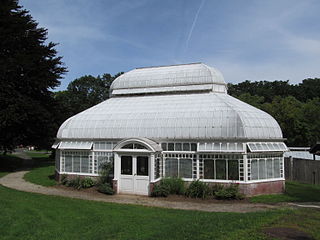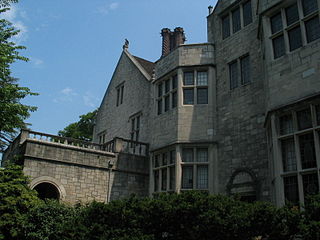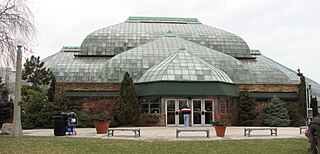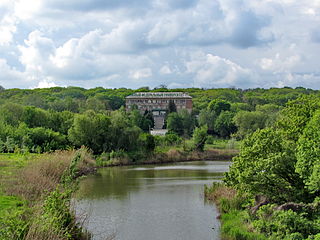
An arboretum is a botanical collection composed exclusively of trees of a variety of species. Originally mostly created as a section in a larger garden or park for specimens of mostly non-local species, many modern arboreta are in botanical gardens as living collections of woody plants and is intended at least in part for scientific study.

A perennial plant or simply perennial is a plant that lives more than two years. The term is often used to differentiate a plant from shorter-lived annuals and biennials. The term is also widely used to distinguish plants with little or no woody growth from trees and shrubs, which are also technically perennials.

The Arnold Arboretum of Harvard University is a botanical research institution and free public park, located in the Jamaica Plain and Roslindale neighborhoods of Boston, Massachusetts. Established in 1872, it is the oldest public arboretum in North America. The landscape was designed by Charles Sprague Sargent and Frederick Law Olmsted and is the second largest "link" in the Emerald Necklace. The Arnold Arboretum's collection of temperate trees, shrubs, and vines has a particular emphasis on the plants of the eastern United States and eastern Asia, where arboretum staff and colleagues are actively sourcing new material on plant collecting expeditions. The arboretum supports research in its landscape and in its Weld Hill Research Building.

Fairchild Tropical Botanic Garden is an 83-acre (34 ha) botanic garden with extensive collections of rare tropical plants including palms, cycads, flowering trees, and vines. It is located in the city of Coral Gables, Miami-Dade County, just south of Miami, surrounded at the north and west by Matheson Hammock Park.

New England Botanic Garden at Tower Hill is a 171-acre botanic garden and arboretum located in Boylston, Massachusetts, approximately 8 miles (13 km) north of central Worcester in Worcester County, Massachusetts. The Garden features 18 distinct gardens, preserved woodlands, and miles of walking trails.

The Cheyenne Botanic Gardens are located in Lions Park in Cheyenne, Wyoming, with an associated High Plains Arboretum located five miles (8 km) northwest of Cheyenne at an elevation of 6,200 feet (1,900 m).

The Connecticut College Arboretum is a 300 ha arboretum and botanical gardens, founded in 1931, and located on the campus of Connecticut College and in the towns of New London and Waterford, Connecticut, United States.

The Mount Holyoke College Botanic Garden, in South Hadley, Massachusetts, United States, encompasses the Mount Holyoke College campus, an arboretum, numerous gardens, and the Talcott Greenhouse. It was first designated a botanical garden in 1878, with guidance from Lydia Shattuck, professor of botany. The construction of the Talcott Greenhouse complex, which houses the Botanic Garden's collection of non-hardy plants, began in 1896, after the original greenhouse was destroyed by fire, and was completed in 1899.
The Buffalo and Erie County Botanical Gardens are botanical gardens located within South Park in Buffalo, New York, United States. These gardens are the product of landscaping architect Frederick Law Olmsted, glass-house architects Lord & Burnham, and botanist and plant-explorer John F. Cowell.

Highland Park, also known as Highland Botanical Park, is an arboretum in Rochester, New York, United States. Its administrative office is located at 171 Reservoir Avenue in Rochester. The park is one of several in Rochester originally designed by Frederick Law Olmsted, including Genesee Valley Park, Maplewood Park, and Seneca Park, which is now a zoo.

The University of California Botanical Garden is a 34-acre botanical garden located on the University of California, Berkeley campus, in Strawberry Canyon. The garden is in the Berkeley Hills, inside the city boundary of Oakland, with views overlooking the San Francisco Bay. It is one of the most diverse plant collections in the United States, and famous for its large number of rare and endangered species.

Planting Fields Arboretum State Historic Park, which includes the Coe Hall Historic House Museum, is an arboretum and state park covering over 400 acres (160 ha) located in the village of Upper Brookville in the town of Oyster Bay, New York.

The University of Michigan Matthaei Botanical Gardens includes botanical gardens, natural areas with trails, and several research-quality habitats and is part of the organization Matthaei Botanical Gardens and Nichols Arboretum. The conservatory is popular year round. The public entrance is at 1800 North Dixboro Road in Ann Arbor, Michigan. The grounds are open every day, but trails are not maintained in the winter. The conservatory, garden store, and lobby are open 7 days a week. The building complex is only closed on three holidays a year.

The University of Illinois Conservatory and Plant Collection is a 2,000-square-foot (190 m2) conservatory and botanical garden located in the Plant Sciences Laboratory Greenhouses, on the University of Illinois at Urbana–Champaign campus, 1201 South Dorner Drive, Urbana, Illinois. The conservatory is generally open to the public daily when the university is in session, though it may be closed for classes, research, or special events.

The Lincoln Park Conservatory is a conservatory and botanical garden in Lincoln Park in Chicago, Illinois. The conservatory is located at 2391 North Stockton Drive just south of Fullerton Avenue, west of Lake Shore Drive, and part of the Lincoln Park, Chicago community area. The Alfred Caldwell Lily Pool and the North Pond Nature Sanctuary are further to the north along Stockton Drive. Along with the Garfield Park Conservatory on Chicago's west side, the Lincoln Park Conservatory provides significant horticultural collections, educational programs and community outreach efforts.

The Orto Botanico dell'Università di Torino is a botanical garden and arboretum operated by the Dipartimento di Biologia Vegetale of the University of Turin. It is located in the Parco del Valentino along the Po River, at Viale Pier Andrea Mattioli, Turin, Italy, and open weekends and holidays during the warmer months; an admission fee is charged.

The M. M. Hryshko National Botanical Garden is located in Kyiv, the capital of Ukraine.

The Wellesley College Botanic Gardens are botanical gardens located on the campus of Wellesley College in Wellesley, Massachusetts. The greenhouses and 22 acres of outdoor gardens include thousands of plants representing over 1,500 different taxa from more than 150 different plant families.

Southern Federal University's botanical garden is located in the North-Western part in Rostov-on-Don, in the Temernik river valley. It's the first botanical garden in the vast territory of the treeless zone in the South of Russia. There is a mineral spring called St.Seraphim of Sarov on the territory of the garden, which is presented by the Directorate of the garden as an Orthodox shrine.




















